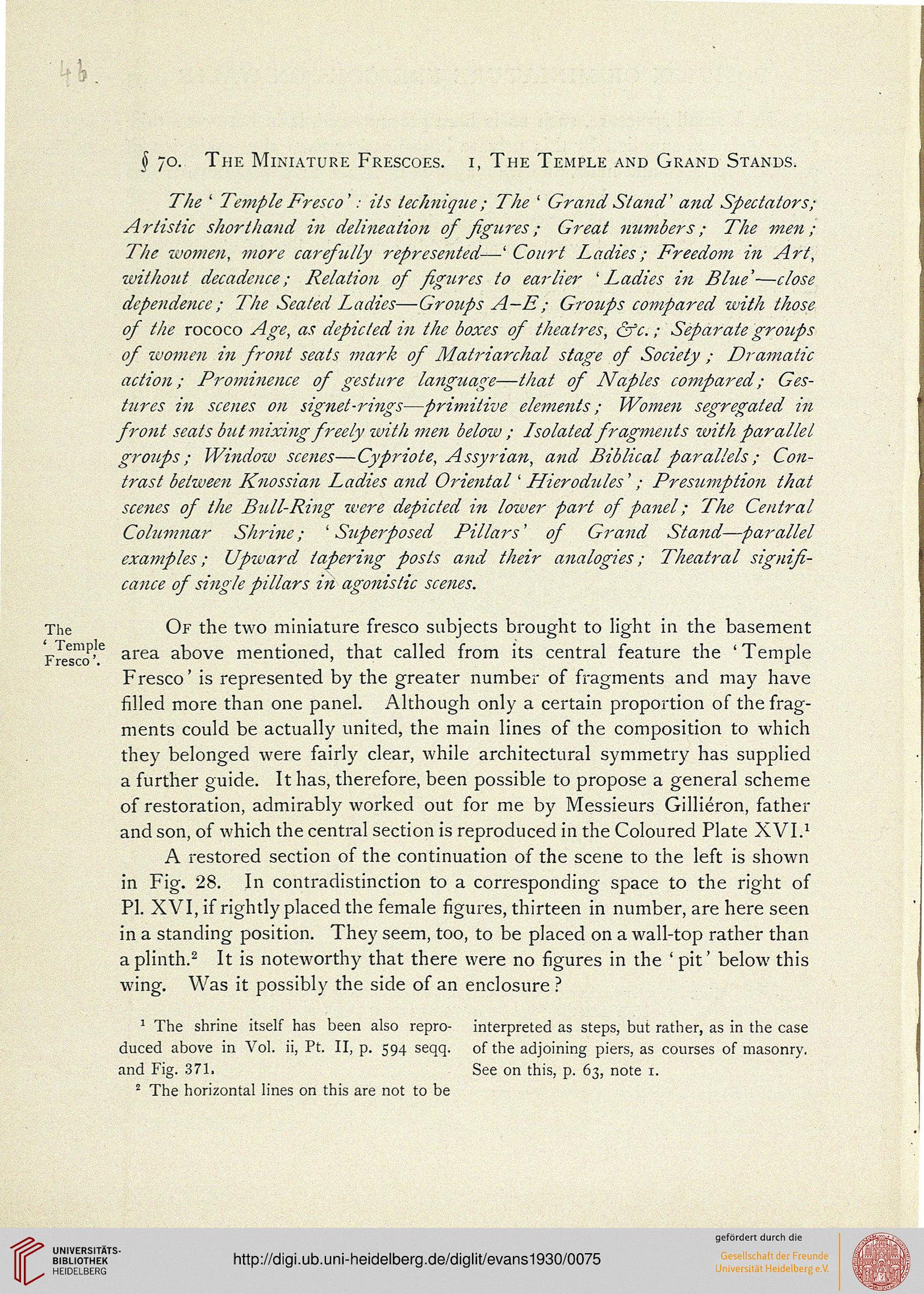§ jo. The Miniature Frescoes, i, The Temple and Grand Stands.
The ' Temple Fresco': its technique ; The ' Grand Stand' and Spectators;
Artistic shorthand in delineation of figures; Great numbers; The men;
The women, more carefully represented—1 Court Ladies; Freedom in Art,
without decadence; Relation of figures to earlier 'Ladies in Blue'-—close
dependence ; The Seated Ladies—Groups A—E; Groups compared with those
of the rococo Age, as depicted in the boxes of theatres, &c.; Separate groitps
of women in front seats mark of Matriarchal stage of Society ; Dramatic
action; Prominence of gesture language—that of Naples compared; Ges-
tures in scenes on signet-rings—primitive elements; Women segregated in
front seats but mixing freely with men below ; Isolated fragments with parallel
groups; Window scenes—Cypriote, Assyrian, and Biblical parallels; Con-
trast between Knossian Ladies and Oriental' Hierodules'; Presumption that
scenes of the Bull-Ring were depicted in lower part of panel; The Central
Columnar Shrine; ' Superposed Pillars' of Grand Stand—parallel
examples; Upward tapering posts and their analogies; Theatral signifi-
cance of single pillars in agonistic scenes.
The Or the two miniature fresco subjects brought to light in the basement
Fresco'6 area at>ove mentioned, that called from its central feature the ' Temple
Fresco' is represented by the greater number of fragments and may have
filled more than one panel. Although only a certain proportion of the frag-
ments could be actually united, the main lines of the composition to which
they belonged were fairly clear, while architectural symmetry has supplied
a further guide. It has, therefore, been possible to propose a general scheme
of restoration, admirably worked out for me by Messieurs Gillieron, father
and son, of which the central section is reproduced in the Coloured Plate XVI.1
A restored section of the continuation of the scene to the left is shown
in Fig. 28. In contradistinction to a corresponding space to the right of
PI. XVI, if rightly placed the female figures, thirteen in number, are here seen
in a standing position. They seem, too, to be placed on a wall-top rather than
a plinth.2 It is noteworthy that there were no figures in the ' pit' below this
wing. Was it possibly the side of an enclosure ?
1 The shrine itself has been also repro- interpreted as steps, but rather, as in the case
duced above in Vol. ii, Pt. II, p. 594 seqq. of the adjoining piers, as courses of masonry,
and Fig. 371. See on this, p. 63, note 1.
2 The horizontal lines on this are not to be
The ' Temple Fresco': its technique ; The ' Grand Stand' and Spectators;
Artistic shorthand in delineation of figures; Great numbers; The men;
The women, more carefully represented—1 Court Ladies; Freedom in Art,
without decadence; Relation of figures to earlier 'Ladies in Blue'-—close
dependence ; The Seated Ladies—Groups A—E; Groups compared with those
of the rococo Age, as depicted in the boxes of theatres, &c.; Separate groitps
of women in front seats mark of Matriarchal stage of Society ; Dramatic
action; Prominence of gesture language—that of Naples compared; Ges-
tures in scenes on signet-rings—primitive elements; Women segregated in
front seats but mixing freely with men below ; Isolated fragments with parallel
groups; Window scenes—Cypriote, Assyrian, and Biblical parallels; Con-
trast between Knossian Ladies and Oriental' Hierodules'; Presumption that
scenes of the Bull-Ring were depicted in lower part of panel; The Central
Columnar Shrine; ' Superposed Pillars' of Grand Stand—parallel
examples; Upward tapering posts and their analogies; Theatral signifi-
cance of single pillars in agonistic scenes.
The Or the two miniature fresco subjects brought to light in the basement
Fresco'6 area at>ove mentioned, that called from its central feature the ' Temple
Fresco' is represented by the greater number of fragments and may have
filled more than one panel. Although only a certain proportion of the frag-
ments could be actually united, the main lines of the composition to which
they belonged were fairly clear, while architectural symmetry has supplied
a further guide. It has, therefore, been possible to propose a general scheme
of restoration, admirably worked out for me by Messieurs Gillieron, father
and son, of which the central section is reproduced in the Coloured Plate XVI.1
A restored section of the continuation of the scene to the left is shown
in Fig. 28. In contradistinction to a corresponding space to the right of
PI. XVI, if rightly placed the female figures, thirteen in number, are here seen
in a standing position. They seem, too, to be placed on a wall-top rather than
a plinth.2 It is noteworthy that there were no figures in the ' pit' below this
wing. Was it possibly the side of an enclosure ?
1 The shrine itself has been also repro- interpreted as steps, but rather, as in the case
duced above in Vol. ii, Pt. II, p. 594 seqq. of the adjoining piers, as courses of masonry,
and Fig. 371. See on this, p. 63, note 1.
2 The horizontal lines on this are not to be





